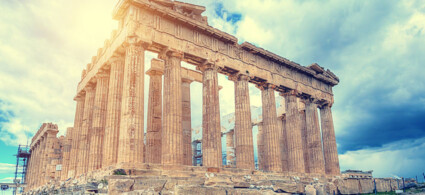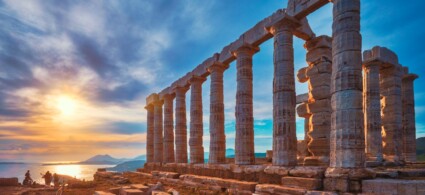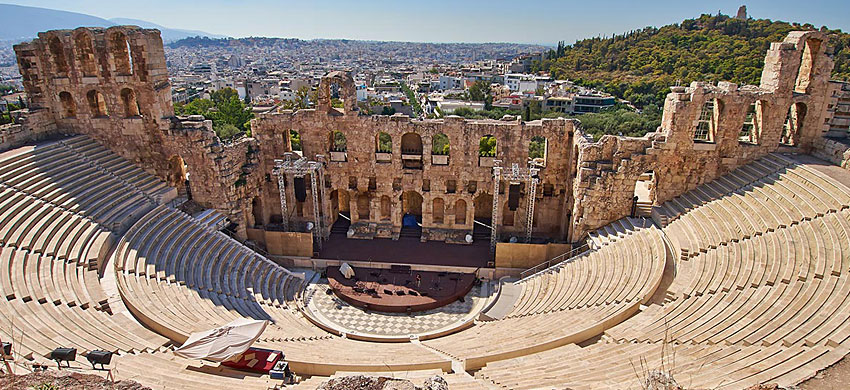

There are many things to see in Athens among which the main one is definitely the Acropolis. In addition to this important archaeological site that stands on the top of a hill in the heart of the city we recommend you to visit the Agora, the second most important site of the capital Attica that lies at the foot of the sacred rock.
Plaka, Monastiraki and Thisio are the districts of Athens most popular with tourists, while young people meet in Psiri and Gazi where the nightlife is concentrated. In summer, however, the center tends to empty out and people flock to the waterfront districts!
Describing in a few lines what Athens has to offer the visitor is impossible: Athens is now a modern capital where ancient art is mixed with new architecture and traditional Greek taverns stand side by side with the new trendy places, all dominated by the Acropolis, the cradle of Western civilization.
To the main places of interest such as the Acropolis1 and the Ancient Agora2 we have dedicated an in-depth study.
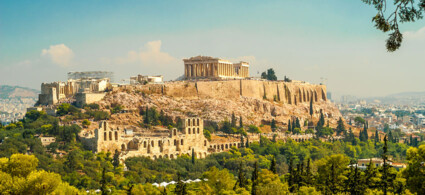
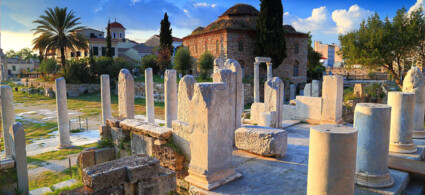
The heart of modern Athens is Syntagma Square or Constitution Square. Here since 1935, in the former King’s Palace, built between 1836 and 1840, is the Hellenic Parliament, designed by the Bavarian architect Von Gartner. Only the palace library is open to the public, while exhibitions are held in the Eleftherios Venizelos Hall.
Easily accessible, Syntagma has one of the most beautiful metro stations in the world. Here you can enjoy a coffee while waiting for the changing of the presidential guard, the famous, statuesque evzones dressed in a uniform of a short skirt and pom-pom shoes inspired by the mountain warriors who fought during the War of Independence. The Changing of the Guard ceremony is held every hour in front of the Tomb of the Unknown Soldier and on Sundays is more elaborate, involving parade dress and a military band.
From Syntagma Square it is easy to reach the city’s main attractions and museums including the Benaki Museum, the Museum of Cycladic Art and the Byzantine Museum. It is also an excellent point to reach Monastiraki and Ermou, one of Athens’ main shopping districts.
The National Archaeological Museum of Athens is located in Odos 28 Oktovriou – also known as ‘Patissìon Street’ – and houses many treasures of Greek archaeology.
To fully appreciate the visit, it is advisable not to miss the following masterpieces, perhaps following a chronological route through the rooms.
Room 4 houses Mycenaean treasures, golden masks, such as that of Agamemnon, discovered in Mycenae by Schliemann, jewellery, ritual vessels, ceramics and frescoes.
Halls 5 and 6 are dedicated to the Neolithic period and the Cycladic civilisation respectively, including interesting types of figurines. Halls 7 to 13 contain sculptures from the 8th to the 6th century BC, in particular of young men ‘kouroi’ and women ‘korai’. In particular in room 8 there is the magnificent kouros discovered in Sounion, returned to Greece after various vicissitudes.
In room 14 there are sculptures from the temple of Aphea and Aegina. In room 15 the classical period begins with the magnificent bronze of 460 BC depicting Poseidon in all his might.
Finally, the votive stele, dating from 440 BC and of great value, depicts a scene from the Eleusinian mysteries. In rooms 16 and 18 there are numerous funerary lekythos (vases) such as the one of Hermes leading a young girl to Hades.
Room 17 houses stelae from the Heraion of Argos, such as the magnificent one of the amphiglyphon. In room 21 is the famous jockey of Artemisius, a bronze of impressive realism. Room 22 contains elements of the Asklipium of Epidaurus. Room 28 displays important masterpieces such as the bronze statuette of an ephebe, dating from 340 BC, and the statue of Perseus. Room 30 houses the Head of Zeus, belonging to a statue that must have been at least 7 metres high, and other works from the Hellenistic period. Rooms 30 to 33 contain works from the Roman period.
The Temple of Zeus, the largest structure of worship of all ancient Greece, is located in the heart of Athens between the Acropolis and Syntagma Square. Its construction was completed in 131 AD by Hadrian after nearly 700 years of work but today we can unfortunately only imagine its ancient splendor.
Built in white marble, the temple dedicated to the king of Olympus impressed the Athenians with its 104 imposing Corinthian columns of which only 15 can still be admired today while a sixteenth lies on the ground after a storm knocked it down in 1852.
The columns of the Temple of Zeus, 17 meters high and each with a diameter of one meter and 70 centimeters, were arranged in two rows of twenty each on the long sides of the temple while under the pediments, on the short sides, stood 3 rows of 8 columns each.
The Temple of Olympian Zeus, originally 96 meters long and 40 meters wide, can be admired from the Acropolis and its ruins are romantically illuminated at night.
The Areopagus Hill is located in the center of Athens and offers wonderful views of the city and the Acropolis. The hill is a popular meeting place.
A great vantage point over Athens, the Acropolis, the Aegean Sea and the port of Piraeus is from Areopagus Hill, a marble spur around which some myths develop including the trial of the council of the gods to Ares for the murder of Alirrotius, son of Poseidon.
Until 462 a. C. on the hill met the elders of the city and held their council here but after some reforms was stripped of these functions transforming it into a land of blood. In classical times, in fact, were executed here the death sentences ordered by the court of Athens for the crimes of murder, treason and corruption.
We also find the name of St. Paul linked to the hill of Areopagus: of his second missionary journey, which took place between 49 and 52 AD to bring the public squares of the intellectual metropolis of Hellenism, we can trace the remains of an ancient church where Paul used to speak to his followers.
Today the hill of the Areopagus is a meeting place for young people especially on hot summer evenings when it is not difficult to meet groups of young people intent on singing and playing the guitar or sipping a couple of beers in the company of a magical view.
The triumphant Hadrian’s Arch is located near Syntagma Square, between the sacred rock of the Acropolis and the temple of Zeus Olympius, and is 18 meters high.
Hadrian ‘s Arch is a triumphal structure located near Syntagma Square right between the rock of the Acropolis and the temple of Zeus Olympius, at the intersection of the busy Leoforos Vasilissis Olgas and Leoforos Vasilissis Amalias.
Built of Pentelic marble in 132 A.D. to celebrate the arrival of the Roman emperor Hadrian and to thank him for his benefactions to the city of Athens, according to some inscriptions on the architrave it was to serve as a divider between the new Roman city and the ancient Greek city.
The arch is 18 meters high and 12.5 wide with a depth of 2.3 and its architecture recalls the Roman arches.
In the 18th century Hadrian’s Arch was one of the seven gates in the defensive wall that the Turks built around the city against the attack of Albanian marauders.
The Panathenaic Stadium is located between the hills of Agra and Ardettos on Vassileos Konstantinouha. In 1896 it hosted the first modern Olympic Games.

The Panathenaic Stadium, i.e. the stadium of all Athenians, was built in the 4th century BC to host athletic competitions to celebrate the city of Athens.
During its history, the Stadium has undergone many changes, some of them radical, so that after centuries of complete abandonment was completely restored in 1895 by a wealthy patron Greek to host the first Olympic Games of the modern era that would be held the following year.
Built in a small natural basin between the hills of Agra and Ardettos, on Vassileos Konstantinou, in the heart of Athens, the current structure has the shape of a horseshoe, with a track 204.07 meters long and 33.35 wide, and is due to the restructuring ordered by Herod Atticus and carried out between 140 and 144 AD, which also introduced marble seats for spectators.
On the track, marble slabs delimit the starting line and the finishing line, while the entrance was enriched with a propylaeum in Corinthian order.
With Christianity and the consequent prohibition of pagan celebrations and barbaric spectacles of the Roman era, the Panathenaic Stadium fell into disgrace and neglect so that its splendid marbles were used to construct the buildings of Athens.
The stadium is open 7 days a week, throughout the year. The cost of admission is 3 euros and includes an audio tour and a brochure in English, French and Greek containing information about the facility.
The National Gardens are located behind the Greek Parliament. Inside are a pond, a small zoo, a botanical museum and a playground.
The National Gardens are located in the heart of Athens just behind the building that houses the Greek Parliament. This true green oasis is the perfect place to escape the hustle and bustle of the city.
The area of the National Gardens includes almost 16 hectares and extends south towards the Panathenaic Stadium.
Not only nature but also memories of the ancient Greek civilization in the National Gardens of Athens, testimonies that come down to us thanks to some ruins including Corinthian capitals, busts and mosaics.
Designed by Amalia of Oldenburg, the queen consort of Otto, the first king of modern Greece, the National Gardens are open to the public from dawn to dusk. The main entrance is located on Vassilissis Amalias, but you can also access from Vasilissis Sofias, Irodou Atticou and Zappeion Park.
Inside the Gardens you will find a pond, 5 small ponds, a small zoo, a botanical museum, a small bar and a children’s library as well as a large playground.
Along the narrow streets, the paths have a total length of 7 and a half kilometers, you can see numerous ornamental plants, cultural elements strongly desired by Queen Amalia and the mosaic floor of a Roman villa as well as the remains of Roman baths.
The large complex of the Roman Baths is located within the National Gardens in the vicinity of the Ilissos River. The structure dates back to the 6th century.
The ruins of the Roman Bath s of Athens came to light during the construction of an air shaft for the subway.
The large thermal complex, built in the vicinity of the Ilissos River within the National Gardens, dates back to the 6th century and is well preserved.
Under Hadrian’s rule, during the expansion of the city and after the completion of the temple of Zeus and the construction of Hadrian’s Arch, the area where the National Gardens are located was annexed to the city. The Roman baths were built after the Eruli incursion of the late third century, and were repaired and expanded in the fifth and sixth centuries.
The archaeological site has been preserved, covered, and made accessible to the public since 2004.
The Zappeion is a sensational example of late Athenian classicism. The building is located between the National Gardens and the Parliament and hosts fine exhibitions.
The Zappeion is one of the most beautiful buildings in Athens, a sensational example of late Athenian classicism.
Built in the second half of the nineteenth century at the behest of Evangelis Zappas, a Greek who had emigrated for years in Romania where he had made his fortune, was designed exclusively to host the fencing championships of the 1896 Olympic Games.
The Zappeion is located between the National Gardens, the Palace of Parliament and the ancient temple of Zeus, and today is used to host public and private exhibitions as well as some ceremonies so as to be called the small parliament.
The palace, painted in the traditional rich rust tones that were used in many ancient Greek buildings, has a semicircular plan, splendid proportions, and features a large oval open space surrounded by a two-story colonnade.
Lycabettus Hill is the highest point in Athens. At the top there is a small chapel, a luxurious cafe – restaurant and an open-air theater.
Lycabettus Hill is the highest point in the heart of Athens and from here you can enjoy a wonderful view of the Acropolis, the city but not only.
The hill is a real green lung in the heart of the dense urbanization of the Greek capital and on clear days will give you beautiful views of the surrounding mountains, the Attica basin to the islands of Aegina and Salamis.
It is possible to reach the hill of Lycabettus on foot thanks to the path that starts from Loukianou, or by car, or by funicular with departures every 30 minutes from the district of Kolonaki.
At the top of the hill you will find the small chapel consecrated to St. George, a luxurious café-restaurant with a splendid terrace and the open-air theater of Lycabettus where various musical performances are hosted, including those of international artists.
The Athens Planetarium is the largest and most advanced digital facility in the world. Opened in 2003, it has a dome with a diameter of 25 meters.
Athens boasts an avant-garde structure in the field of astronomy. In fact, the largest and most advanced digital planetarium in the world is located right here. The Eugenides Foundation structure, inaugurated in 2003, covers an area of 950 square meters and has 280 seats.
The dome is 25 meters in diameter: the 360-degree screen gives the audience the illusion of being transported to various points on the planet of time.
The shows are mostly the Foundation’s own productions, produced with the help of qualified technical personnel at its disposal, and include digital projections, films and large international productions.
Athens is a city rich in museums among which the wonderful Acropolis Museum stands out.
To explore Greek culture, its music and beautiful art collections we have selected for you the best museums in Athens.
The Byzantine and Christian Museum of Athens is located inside a villa of 1840 in Leoforos Vassilissis Sofias 22.
In the large pavilion at the back is a collection of 4th century funerary stelae, friezes, capitals, pulpits of early Christian churches, silver, ivory and mother of pearl tabernacles, frescoes, icons and religious jewelry.
On the second floor of the museum you can admire beautiful iconostasis doors inlaid with mother-of-pearl and painted figures from the fifteenth century, bronzes, ancient icons and frescoes, such as the Death of the Virgin.
The building to the left of the main body houses some temporary exhibitions.
The prestigious Museum of Cycladic and Ancient Greek Art is located in an elegant building of white marble and glass in odos Neofitou Douka 4.
On the first floor of the museum are many examples of Cycladic art from the 3rd millennium BC.
On the second floor are the most important works of the museum belonging to a rich collection of Cycladic sculptures, still of largely mysterious significance.
The second floor shows bas-reliefs of ancient Greece, Phoenician glass, amphorae, bronze tableware from Askio.
The third floor is dedicated to numismatics and the fourth floor to the Politis collection: terracotta, pottery, bronze kylix (goblets), weapons and helmets. The new wing, Stathatos Palace, houses temporary exhibitions.
The Benaki Museum houses works of art ranging from the Hellenistic period to modern times. The Museum exhibits mainly elements of national culture.
The Benaki Museum is housed in an aristocratic mansion in odos Koumpari, near Sindagma Square.
The museum building belonged to Antonis Benaki, a collector of works of art ranging from Hellenism to modern times.
The Museum exhibits mainly items belonging to the national culture – for example, on the first floor there are bronze weapons, rare helmets, jewelry and pottery from the Archaic period, precious gold jewelry from the 3rd century BC. – funeral paintings from El Fayum, the famous door of the sanctuary of Epirus depicting the theme of the Annunciation.
The new wing of the museum houses works from the Christian and Byzantine periods. Of particular note is the splendid 10th century mosaic of the Virgin from the destroyed monastery of Constantinople.
On the second floor the display of religious art objects is still dominant but there is no lack of secular works such as embroidery, Rhodes cloths and wedding dresses.
On the second and third floors of the Benaki Museum are the objects belonging to the fighters of the Greek revolution against the Turks and of independence. From weapons to glasses of the heroine Laskarina Bouboulina, from photos of Venizelos to documents on the great figures of Greek literature of the 20th century.
There is also a restaurant inside the museum.
A second location of the Benaki Museum is located in Pireos Street in the Gazi district. The space is immense and is used to stage exhibitions of contemporary artists. Inside there is a cafeteria and an internet point.
The Museum of Greek Folk Art is located in odos Kydathineon, in the Plaka district. On the first floor there is a collection of large embroideries, on the second floor are exhibits on the shadow theater (Karaguiozis) and on the carnivals of northern Greece, direct descendants of the Dionysian festivals. The second floor is dedicated to silver objects and the third to traditional costumes, which differ from region to region.
The Museum of Greek Folk Music Instruments is located in Aerides Square and presents the four types of Greek musical instruments. Gaidas, tsambounes, zournades, baglamas, bouzouki and Cretan lyres, from the collection of Fivos Anoyanakis, can be heard through the headphones available near the showcases. Inside the museum there is also a Bookshop. Also during the summer concerts and teaching courses are held.
The Tsizdaraki Mosque dates back to 1759 and is located in the main square of Monastiraki. Now deconsecrated, it preserves magnificent ceramics and houses works by great artists of the 20th century.
They are degfli the ancient Turkish public baths, which are located in odos Kyrristou, near the Tower of Winds. They host a video room and temporary exhibitions.
The Canellopoulos Museum is located in odos Theorias and Panos 12 and preserves evidence of antiquity, such as Cycladic vases and figurines, Hellenism and the Byzantine period. The Deposition of Christ by Tzanes and the painting of the naive painter Theophilos are noteworthy.
It is located in the center of Plaka, in odos Monis Asteriou 3-7, and the two buildings, one in neoclassical style, the other in Art Nouveau style, are dedicated to modern Greek and European painting. There are more than 3000 works and they are exhibited in rotation. Temporary exhibitions are held at entrance number 3 and there is a cafeteria in the basement.
The museum, in odos Kallisperi, houses the creations of the jeweler Lalaounis, inspired by ancient Greek art and 12 other civilizations, such as the Celtic. Important is the treasure of Priam discovered by Schiliemann, on the second floor. Present inside a cafeteria and a bookshop.
It is located in odos Melidoni, near the cemetery of the Ceramic. The works of Greek potters of the nineteenth and twentieth centuries are housed in an elegant bourgeois residence. Fascinating to discover the materials, techniques, customs and habits regarding the vases. Inside the museum there is also a cafeteria and a bookshop.
It is located in odos Pireos, in the district of Gazi. Fans will surely be pleased to see the photos, letters and clothes of their diva.


